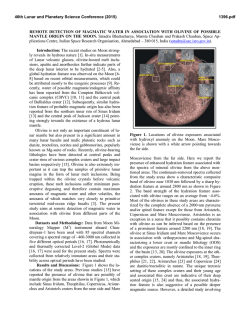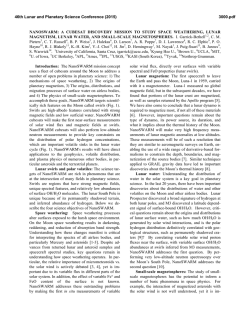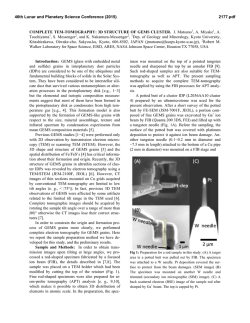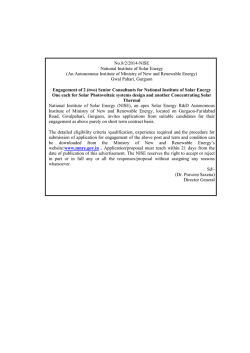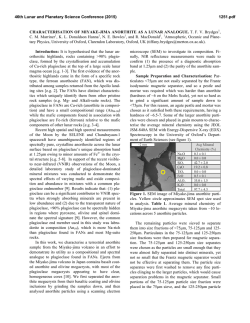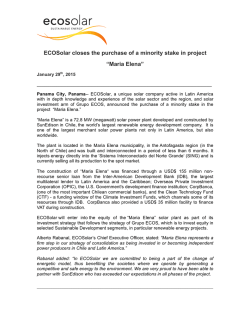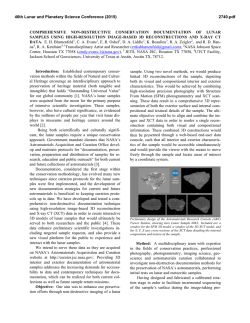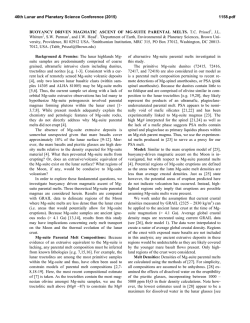
SOLAR FLARE TRACK EXPOSURE AGES IN - USRA
46th Lunar and Planetary Science Conference (2015) 1543.pdf SOLAR FLARE TRACK EXPOSURE AGES IN REGOLITH PARTICLES: A CALIBRATION FOR TRANSMISSION ELECTRON MICROSCOPE MEASUREMENTS. Eve L. Berger1 and Lindsay P. Keller2, 1 Geocontrol Systems – Jacobs JETS contract – NASA Johnson Space Center, Houston TX 77058, [email protected], 2ARES, Code XI3, NASA Johnson Space Center, Houston, TX 77058. Introduction: Mineral grains in lunar and asteroidal regolith samples provide a unique record of their interaction with the space environment. Space weathering effects result from multiple processes including: exposure to the solar wind, which results in ion damage and implantation effects that are preserved in the rims of grains (typically the outermost 100 nm); cosmic ray and solar flare activity, which result in track formation; and impact processes that result in the accumulation of vapor-deposited elements, impact melts and adhering grains on particle surfaces. Determining the rate at which these effects accumulate in the grains during their space exposure is critical to studies of the surface evolution of airless bodies. Solar flare energetic particles (mainly Fe-group nuclei) have a penetration depth of a few millimeters and leave a trail of ionization damage in insulating materials that is readily observable by transmission electron microscope (TEM) imaging. The density of solar flare particle tracks is used to infer the length of time an object was at or near the regolith surface (i.e., its exposure age). Track measurements by TEM methods are routine, yet track production rate calibrations have only been determined using chemical etching techniques [e.g., 1, and references therein]. We used focused ion beam-scanning electron microscope (FIB-SEM) sample preparation techniques combined with TEM imaging to determine the track density/exposure age relations for lunar rock 64455. The 64455 sample was used earlier by [2] to determine a track production rate by chemical etching of tracks in anorthite. Here, we show that combined FIB/TEM techniques provide a more accurate determination of a track production rate and also allow us to extend the calibration to solar flare tracks in olivine. Samples and Techniques: Apollo rock 64455 is an oriented, glass-coated impact melt rock. The splash glass has partly devitrified with inwardly radiating plagioclase and olivine crystals, which nucleated from multiple points on the glass surface. Both of these minerals record solar flare particle tracks. This sample has an exposure age of 2 × 106 year based on Kr-Kr dating [2]. We obtained a thin section of 64455,14 with the same orientation as the sample studied by [2]. Initial x-ray mapping and BSE imaging were done on the JEOL 7600 SEM (fig. 1a/b). Four electron transparent FIB sections were prepared using an FEI Quanta 3D FIB-SEM. The FIB sections were prepared with particular attention to the FIB section orientation relative to the rock’s zenith, as well as depth below the surface. STEM analyses (bright and dark field imaging (BFI/DFI)) of the FIB sections were done on the JEOL 2500 field emission STEM. All instruments are housed at NASA JSC (e.g., fig. 1c/d). Results: We observed similar track densities registered by anorthite and olivine at similar depths (fig. 2). Previous work has shown that the 64455 had a stable orientation during its exposure on the lunar surface and displays a well-developed track density gradient. Our measured track gradient is consistent with those reported for other non-eroded lunar samples (e.g., [2-4]). We measured a maximum track density at the sample surface of 8.2 ±2.4 × 1010 cm-2. Based on this track density and the Kr-Kr exposure age for the splash glass on 64455, we calculate a track production rate at 1 AU of 4.1 ±1.2 × 104 tracks/cm2/y (2π exposure). Discussion: The track production rate we determined is an order of magnitude lower than the 6x105 cm2/y value derived by Blanford et al. [2]. The high surface track densities reported by [2] require normalization and extrapolation of measurements made from greater depths and with corresponding lower (measureable) track densities. We believe this normalization procedure overestimates the surface track density by at least an order of magnitude. In this study, we directly measured the surface track density for 64455. Solar flare tracks are readily identified in TEM images and we directly and accurately measure track densities in samples with densities up to 1011-1012 cm-2 range, whereas the optical and SEM techniques used to count etched tracks are limited to densities of <1010 tracks/cm2. In fact, the highest, directly measured track density reported in [2] is in the mid-109 range. In TEM images, defects and grain boundaries are easily distinguished from solar flare particle tracks, and are definitively excluded from our track density counts. There are a number of important applications of solar flare track density data. For example, we use the solar flare track density as a proxy for surface exposure age to place constraints on the rates of space weathering processes in lunar soils [5], and on the rates of patina accumulation on lunar rocks [6]. Using the calibration for olivine, measured track densities in regolith grains returned by JAXA’s Hayabusa mission to asteroid Itokawa can be used to infer regolith dynamics on that body [7-9]. These studies show that the Hayabusa grains have exposure ages (105-106 y) comparable to grains in submature lunar soils [8]. 46th Lunar and Planetary Science Conference (2015) This production rate may also be applied to TEM measurements of track densities in interplanetary dust particles (IDPs) to determine a minimum exposure age, keeping in mind that these grains have not been at 1AU for their lifetime (the solar flare flux falls off by an inverse square law with heliocentric distance [10]) and they had a 4π exposure. Conclusions: 1.) We determined a track production rate of 4.1 ±1.2 × 104 tracks/cm2/year at 1 AU, based on TEM measurements. 2.) Anorthite and olivine record the same track densities, which enables this track production rate to be applied to a wider range of samples. 3.) FIB-preparation of samples increases the surface area over which track densities are measured 1543.pdf relative to microtome prepared samples. 4.) We emphasize that this calibration is only directly applicable to TEM measurements obtained on anorthite and olivine grains that were exposed at ~1 AU. Extending this calibration to other mineral types at other heliocentric distances will require further extrapolations. References: [1] Zinner (1980) Proc. Conf. Ancient Sun, 201-226. [2] Blanford et al. (1975) Proc. 6th Lunar Sci. Conf., 3557-3576. [3] Walker & Yuhas (1973) Proc. 4th Lunar Sci. Conf., 2379-2389. [4] Crozaz et al. (1974) Proc. 5th Lunar Sci. Conf., 2475-2499 [5] Zhang & Keller (2012) 75th Met. Soc. Mtg., #5267. [6] Noble et al. (2012) LPSC XLIII, #1239. [7] Noguchi et al. (2014) [8] Keller & Berger (2014) 77th Met. Soc. Mtg., #5088. [9] Berger & Keller (2014) this volume. [10] Blanford (1993) LPSC XXIV, 131-132. 1c 1a Fig. 1a. BSE image and 1b. x-ray maps of radiating anorthite and olivine crystals from sample 64455, The locations of the four FIB sections are indicated. 1c. Bright-field STEM image of FIB section 5. Solar flare track densities were measured as a function of depth. The box in fig. 1c indicates the location of the image shown in fig. 1d. 1d. Bright-field STEM image from FIB section 5. The solar wind damaged rim, with a width of ~70 nm, can be seen at the top of the image. Numerous solar flare particle tracks are visible in the plagioclase as dark linear features. 1b 1d Solar wind damaged rim Solar .lare particle tracks Fig. 2. Track density decreases with depth. The average track density, at the grain surface, is 8.2 ± 2.4 × 1010 tracks/cm2. Coupled with the Kr-Kr age of 2×106 year [2], the track production rate at 1 AU is calculated to be: 4.1 ± 1.2 × 104 tracks/cm2/year.
© Copyright 2025
